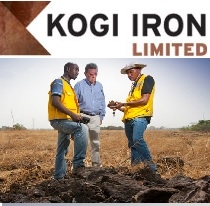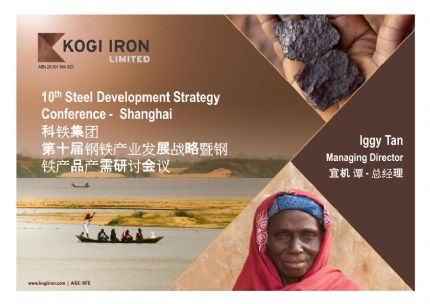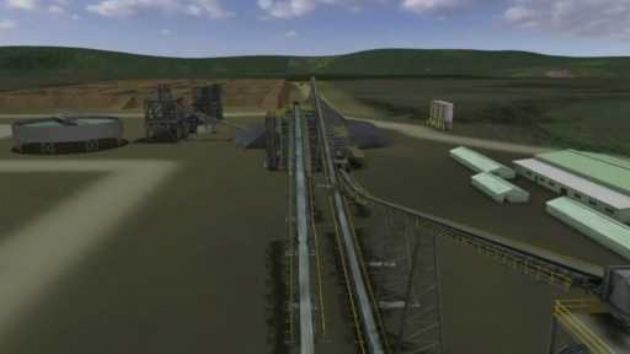 Company Interview with Managing Director
Company Interview with Managing Director
Perth, Feb 10, 2014 AEST (ABN Newswire) - Australian based iron ore development company, Kogi Iron Limited ( ASX:KFE) (“Kogi”, “Kogi Iron”, or the “Company”) and its 100% owned Nigerian operating company, KCM Mining Limited (“KCM”) are pleased to announce a Record of Interview conducted with Managing Director, Mr Iggy Tan by Company Interview.
ASX:KFE) (“Kogi”, “Kogi Iron”, or the “Company”) and its 100% owned Nigerian operating company, KCM Mining Limited (“KCM”) are pleased to announce a Record of Interview conducted with Managing Director, Mr Iggy Tan by Company Interview.
The Question and Answer serves a useful background to the recently completed Preliminary Feasibility Study on the Agbaja Iron Ore Project in Nigeria.
Record of interview:
Company Interview question:
Kogi Iron Limited (ASX code: KFE, market capitalisation of ~$30 million) recently announced a positive and robust Preliminary Feasibility Study (PFS) on its 100% owned Agbaja Iron Ore Project in Nigeria. How important is successfully completing a PFS in terms of moving towards a commercial project at Agbaja? Can you briefly outline the next milestones for Agbaja and a timeline?
Managing Director, Iggy Tan
Completing the Preliminary Feasibility Study (PFS) is a very important step towards moving to a commercial project at Agbaja and we’re very pleased with the outcome.
The PFS is a very comprehensive study and we’ve completed the work ahead of schedule. The results show a very positive set of economics, mainly centred on the low capital intensity of the project which is estimated at US$99/t of annual production. This places Agbaja in the bottom quartile of magnetite projects around the world on that measure. The capital intensity number is more comparable with some of the hematite direct shipping ore (DSO) projects.
The Agbaja deposit is unique because of the soft ore, low strip ratio, relatively simple processing and importantly proximity to the Niger River and barge transport. These positives have resulted in lower than envisaged operating costs; especially transport costs as barging is cheaper than other forms of bulk commodity transport such as truck or rail.
The estimated operating costs of US$43/t ranks Agbaja in the lowest half of magnetite projects around the world. The operating cost is also comparable with some DSO projects.
The capital payback is only 4 years and the Kogi Board has agreed to proceed to a Definitive Feasibility Study which will be completed by the end of the December quarter 2014. That is the next major milestone for the project and will be our main focus this year.
Company Interview question:
Can you outline the scope of the project in terms of the physical parameters and the logistics of getting the magnetite concentrate from mine to port to customers? Can you explain the process of producing a magnetite concentrate?
Managing Director, Iggy Tan
The project will produce 5 million tonne of iron ore concentrate per annum. As I’ve said, Agbaja is a unique magnetite deposit. For example, the average in-situ grade we’re targeting for mining is around 45% iron which is very high for magnetite deposits, these type of deposits typically have iron grades that range from around 25% iron to 40% iron. Due to the softness of the Agbaja ore and its sedimentary nature, it lends itself to simple and low cost mining and treatment processes.
The treatment process requires simple crushing to around 250 micron (1/4 of a millimetre) and requires only magnetic separation to upgrade the material. There is no need for gravity separation, dense media or flotation. Most magnetite projects have to grind to less than 45 micron. The concentrate will be pumped by pipeline from the Agbaja Plateau down to the Niger River where it will be filtered and loaded onto river barges for transport around 600 kms to a transfer station in the Gulf of Guinea, where the concentrate will be transferred onto ocean going barges. The ocean going barges then travel around 33 kms out in the Gulf of Guinea where the concentrate is stored on a floating trans-shipper before being loaded onto large cargo ships for transport to customers around the world. The trans-shipper is large enough for us to load cape size ships, which are the largest available. As I’ve said, river barge is the cheapest transport available for bulk commodities.
Company Interview question:
Can you explain why the economics of Agbaja are robust? Can you explain the rationale for the main assumptions used?
Managing Director, Iggy Tan
The biggest drivers for the attractive economics are the low capital intensity and low operating costs. The pre-tax NPV for the project is US$420 million at a discount rate of 12% and the project has an IRR of 23.7%. The operating margin is around US$30/t which is very strong and results in an EBITDA of US$136 million per annum.
The low operating costs are driven by mining costs, processing costs and transport costs. The mining cost is quite favorable because of a very low strip ratio (it is a shallow deposit requiring little removal of waste material). The softness of the ore means we don’t have to drill and blast. On the processing, the ore liberates at a coarse particle size and only requires low to medium grinding resulting in a coarse particle size of 250 micron. That reduces the amount of energy required in processing. Finally, the transport costs through barging are low.
Obviously the pricing of the finished product is an important assumption. The Agbaja iron ore concentrate will be low in silica and we believe highly sought after for blending with concentrate that is high in silica. We have assumed a long term price of US$73/t of concentrate FOB, and we have allowed for an elevated phosphorous and alumina content discount in this price assumption.
Company Interview question:
Can you compare the quality of Agbaja with other projects, particularly in terms of location, ore quality, infrastructure, strip ratio, capital intensity and operating costs? What disadvantages will project management have to deal with?
Managing Director, Iggy Tan
The biggest advantage of the project is its proximity to transport infrastructure. Transport is vital for any iron ore project with sometimes billions of dollars being required to build new infrastructure. This can lead to excellent iron ore deposits being left stranded and undeveloped for years because there is no cost effective way to transport the product to a port and onwards world markets. At Agbaja, the FOB barging cost, including loading and offloading to the customer’s ship, is estimated at US$19/dmt of iron ore concentrate, or a rate of 2.96 cents per tonne kilometre.
The next advantage of Agbaja is the sheer size of the existing deposit and the potential to grow this rapidly. We currently have a JORC Mineral Resource of 586 million tonnes, but we have only drilled around 19% of the deposit within Exploration License EL12124 which is one of 17 Exploration Licenses that we hold in Nigeria. Our Exploration Target across all of our Exploration Licenses is currently around 3 billion tonnes.
Then there is the unique nature of the Agbaja ore. It is very soft, has a high liberation size and therefore requires little grinding, with only magnetic separation required. This contributes greatly to the low capital intensity and low operating cost. The ore is also close to the surface with very little overburden resulting in an average strip ratio for the first 21 years of 0.55 to 1, which is extremely low. The ore body is consistent at about 12-13 metres thick, pretty much across the whole plateau.
The main disadvantages are the elevated phosphorous and alumina levels of the finished product, but as I’ve explained we have allowed discounts for those impurities in our pricing assumptions. There is interest for the product today.
Company Interview question:
The current JORC Mineral Resources is estimated at 586 million tonnes at 41.3% Fe. What is the current classification and quality of the Mineral Resources? Can you explain how that will support a 5mtpa operation returning the project economics outlined? How will you progressively upgrade and expand the Mineral Resources?
Managing Director, Iggy Tan
We currently have an Indicated Mineral Resource of 488 million tonnes at 41.4% Fe and that will support a 5mtpa project for in excess of 35 years, our current mine plan involves producing at that rate for an initial 21 years. There is a high degree of geological confidence in the Indicated Resource, there is more than enough ore to support the initial 21 years of planned mine life.
As I’ve said, we’ve only drilled around 19% of our total tenement area and if we consider an expansion above 5mtpa, it will be in 5mtpa modules. Next year we will probably do some further drilling and would hope double the resource and add around another 0.5 billion tonnes.
Company Interview question:
Can you describe the regional geology with respect to its prospectivity for iron ore? Where does Agbaja sit in terms of Kogi’s iron ore licenses?
Managing Director, Iggy Tan
Agbaja sits on a plateau which is sedimentary. The deposit is very simple to mine because it is only about 6 metres below surface, is continuous and consistent at around 12-13 thickness. The average grade of the ore we are targeting is around 45-46% Fe, which would make it about the highest grade known magnetite deposit in the world.
Company Interview question:
Can you describe the social, fiscal and political risks? From here, which areas will require most management to get the project into production? How will you foster relationships with local communities?
Managing Director, Iggy Tan
We have completed an Environmental and Social Impact Assessment (ESIA), which was a major component of the PFS. This extensive report concludes that there are no environmental show stoppers for the project. The mining area we’re targeting is on low value scrub land and there is no endangered flora or fauna existing in that area.
There are major potential positive impacts for the local communities. Our existing staff are mainly from the local communities, many more local jobs will be created, and there will be flow on, multiplier effects to other industries. We will also be training local people. The operation workforce will be between 500-600 people and up to 1,000 people during construction.
Kogi has very good relationships with the Agbaja community, local government and the Nigerian Federal Government. The Federal Government has a clear strategy to diversify the Nigerian economy from its current reliance on the very large oil and gas industry, the government is supporting and encouraging the mining industry as a sector to help lead this diversity push. A significant amount of the relatively new mining legislation in Nigeria is similar to Western Australian legislation and there is a very transparent fiscal regime. The Government has a policy to act as a regulator only in the industry and not seek equity participation.
Company Interview question:
Can you give more detail on the main components of the capital cost and operating costs? What are the main risks in achieving these?
Managing Director, Iggy Tan
The main components of the operating cost are mining at around US$8/t of concentrate, processing at around US$17/t of concentrate and transport including slurry pumping, barging and shipping at around US$18/t of concentrate.
The main areas of capital costs are mine development at US$11.9 million, processing plant at US$132.7 million, pipeline, Banda and Escravos barging facilities at US$120.2 million, utilities and infrastructure at US$108.2 million, EPCM at US$46.5 million, spares, first fills and working capital of US$32.5 million and a contingency of US$45.1 million for a total of US$497.1 million.
The main de-risking area that we will be concentrating on in the DFS is ensuring a seamless barging operation, we want to engage with the operators during this DFS stage. We want to finalise gas supply for our power station, we are aware of an unused gas pipeline which runs just near our project, so we want to tap into this. We also want to do some pilot plant work on the bioleaching process, which is quite exciting.
Company Interview question:
What are your views on the supply/demand dynamics for the iron ore market and for new magnetite projects such as Agbaja? What will drive the development of the West African iron ore industry?
Managing Director, Iggy Tan
Investec Bank believes that West Africa has the potential to become the next global iron ore centre and we support that view. The current major iron ore producers enjoy an oligopoly, with China over-reliant on imports from Australia and Brazil, so we think that customers will support the development of a new world iron ore hub. There are several iron ore deposits in West Africa with potential for early development because of their quality and location close to transport infrastructure. These projects will tend to have lower capital cost intensity and lower operating costs on a world-wide comparison. There is a lot of interest from customers, particularly from China, for West African iron ore.
Our market consultant, AME Group, expect that the short term demand for iron ore will remain strong as China looks for additional iron ore supply to replace its diminishing domestic deposits. In the longer term AME expect that demand for iron ore will benefit from the accelerating industrialisation in countries such as India, Indonesia and Vietnam, plus of course a continued high level of demand from China.
Company Interview question:
What is Kogi’s funding strategy for Agbaja? What funding types are possible for Kogi? Is a joint venture partner a possibility?
Managing Director, Iggy Tan
Our main focus is to complete the DFS and as part of that process we will be talking to various potential partners including potential off take partners. I believe funding opportunities will arise as we continue to advance and de-risk the project. We will consider all viable funding opportunities available to us as they evolve during the DFS.
Company Interview question:
Can you summarise the project risks and also any optimisation/upside opportunities that you have identified?
Managing Director, Iggy Tan
The risks for Agbaja are similar to those associated with a mining project in any developing country. However we are reassured in that Nigeria has internationally competitive and transparent mining legislation similar to that in Australia and other established mining jurisdictions; there are excellent mining contractors and construction companies that have been operating in West Africa for many years, some of them with Australian roots. Also, many global infrastructure companies operate in Nigeria and Africa.
There are risks associated with all new mining projects, but we don’t have any out of the ordinary and we believe that all of the risks are manageable.
The optimisation opportunities will centre on capital costs and operating costs. An expansion is certainly possible down the track, but at the moment we are totally focused on an initial 5mtpa project.
Company Interview question:
As Kogi continues to de-risk the Agbaja Iron Ore Project and add value for shareholders, how do you see Kogi adding further shareholder value either through expanding Agbaja, developing additional projects or other initiatives?
Managing Director, Iggy Tan
The best value for our shareholders is for the company to remain focused on delivering the DFS for Agbaja in a timely and thorough manner. We have an excellent project which can deliver very significant value for shareholders. Once we establish the initial project it will open up all sorts of expansion opportunities, but as I’ve said we are totally focused in delivering value to shareholders through establishing the initial 5mtpa Agbaja project.
Company Interview question:
Thanks Iggy.
About Macro Metals Limited
Macro Metals Limited is an ASX-listed company (ASX:M4M) with the intent to build a cast steel plant on the Agbaja Plateau in Kogi State, Nigeria. The project will utilise company leased iron ore deposits and will supply a cast steel feedstock to steel manufacturing and product fabricators in Nigeria and overseas.
![abnnewswire.com]()
Related Companies
Social Media
Share this Article

 ASX:KFE) (“Kogi”, “Kogi Iron”, or the “Company”) and its 100% owned Nigerian operating company, KCM Mining Limited (“KCM”) are pleased to announce a Record of Interview conducted with Managing Director, Mr Iggy Tan by Company Interview.
ASX:KFE) (“Kogi”, “Kogi Iron”, or the “Company”) and its 100% owned Nigerian operating company, KCM Mining Limited (“KCM”) are pleased to announce a Record of Interview conducted with Managing Director, Mr Iggy Tan by Company Interview.




